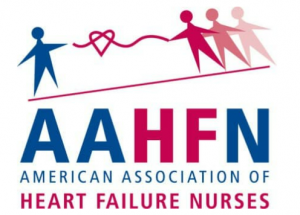AAHFN’s 17th Annual Meeting Week Starts Today
AAHFN's 17th Annual Meeting starts this week, from Thursday, June 17th to Friday, June 18th with Pre-Conference Workshops taking place on Wednesday, June 16th.
MOUNT LAUREL, NEW JERSEY, UNITED STATES, June 17, 2021 /EINPresswire.com/ -- The American Association of Heart Failure Nurses (AAHFN) is starting their 17th Annual Meeting virtually this week, from Thursday, June 17th to Friday, June 18th with Pre-Conference Workshops taking place on Wednesday, June 16th. The meeting runs from 8 AM to 6 PM EDT and is tailored to address the educational needs of members of the heart failure team including nurses, physicians, pharmacists, and early career trainees.“Heart failure (HF) is a major public health problem and timely evidence-based guideline directed treatment is essential to ensure optimal patient outcomes”, Kelly D. Stamp, PhD, ANP-C, RN, CHFN-K, FAHA, FAAN, Professor & Department Chair, Family & Community Nursing at The University of North Carolina Greensboro.
AAHFN’s Annual Meeting offers heart failure professionals the opportunity to advance their understanding and knowledge of heart failure with a robust, multidisciplinary program. Content is delivered through a variety of formats including educational sessions, state-of-the-art industry sponsored symposia and product theatres, workshops, and research and practice improvement oral and eposter presentations of accepted abstracts.
Educational sessions will be led by highly knowledgeable, guest and member industry expert speakers, and have broken down into four main topic areas (Advanced, Fundamental, Global and the Amyloid track); these sessions have been carefully selected to cater to the needs of heart failure nurses and professionals. AAHFN will highlight high priority issues such as:
• The Diagnosis, Management and Prevention of Heart Failure
• Implications and Results of COVID-19 and Heart Failure Patients
• Understanding Transthyretin Amyloidosis (ATTR) and Hereditary Transthyretin Amyloidosis (hATTR)
• Symptoms and Treatments of Heart Failure with Reduced Ejection Fraction (HFrEF)
• Decision-Making and Assessing The New York Heart Association (NYHA) Functional Class of Patients with Heart Failure
Attendance to AAHFN’s Annual Meeting will award up to 40 Continuing Education Hours (CEUs), which can be used towards heart failure certification requirements. More information regarding certification can be found at https://www.aahfn.org/mpage/certificationboard1. Annual Meeting content will also be recorded so attendees have the option to attend educational sessions live, as well as on demand after the event! This is also a great option for those that are interested in attending the meeting but are unable to do so due to prior commitments or conflicts. For more information on AAHFN’s 17th Annual Meeting or for more heart failure related content, please visit www.aahfn.org2.
About Heart Failure
Heart failure, which means the heart does not contract with enough force to pump sufficient blood throughout the body, is a debilitating and life-threatening condition, affecting nearly 6 million Americans.(1,2) It is the leading cause of hospitalization among Americans over the age of 65.(3) Heart failure presents a major and growing health-economic burden that currently exceeds $30 billion in the United States, which accounts for both direct and indirect costs.(1,4)
About the American Association of Heart Failure Nurses (AAHFN)
The AAHFN is a nonprofit specialty organization dedicated to advancing nursing education, clinical practice, and research to improve heart failure patient outcomes. The goal of AAHFN is to set the standards for heart failure nursing care. The American Association of Heart Failure Nurses unites professionals, patients and caregivers in the support and advancement of heart failure practice, education, and research, thus promoting optimal patient outcomes. AAHFN serves as the interface for sharing ideas, translating research findings into practice, and setting priorities for the future. AAHFN focuses on patients across all environments of care from the hospital, to the clinic, to home.
References
1. Mozaffarian D, Benjamin EJ, Go AS, et al. Heart Disease and Stroke Statistics—2016 Update: A report from the American Heart Association. Circulation. 2016; 132:000-000. doi: 10.1161/CIR.0000000000000350.
2. Fauci A, Longo D. Disorders of the Heart. Harrison’s ‘Principles of Internal Medicine. 17th ed. New York, NY; McGraw-Hill Book Co; 2008;4:1442-55.
3. Wier LM, Pfuntner A, Maeda J, et al. HCUP Facts and Figures: Statistics on Hospital-based Care in the United States, 2009. Agency for Healthcare Research and Quality. 2011; 1-3.
4. Heidenreich PA, Albert NM, Allen LA, et al. Forecasting the impact of heart failure in the United States: a policy statement from the American Heart Association. Circ Heart Fail. 2013;6:606-619. Gallagher R, Luttik M-L, Jaarsma T. Social Support and Self-care in Heart Failure. J Card Nurs. 2011; Vol. 26, No. 6, pp 439-445.
Karyn Lockshine
American Association of Heart Failure Nurses
+1 856-793-0806
klockshine@aahfn.org
Visit us on social media:
Facebook
Twitter
LinkedIn
1 https://www.aahfn.org/mpage/certificationboard
2 https://www.aahfn.org


